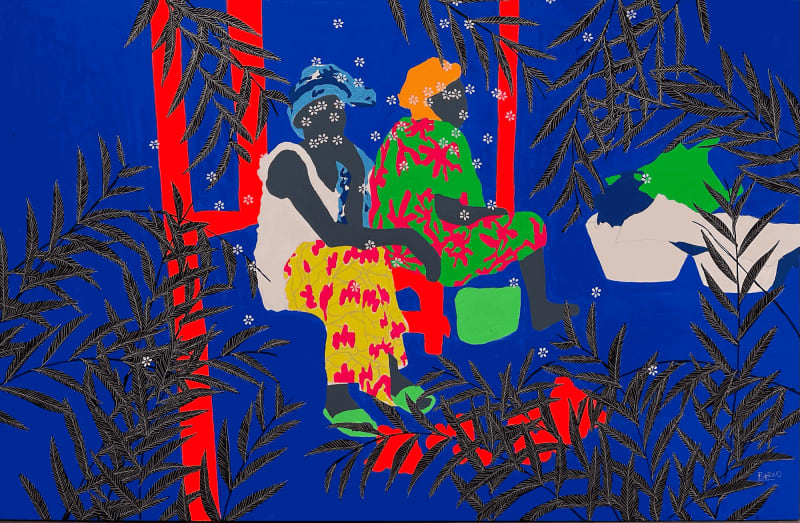By immersing the eye in one same colour, the exhibition space becomes a haven of peace. If Henri Matisse considered colour as the central element of his art for its ability to pick us, Moustapha Baidi Oumarou chooses his palette to calm the mind.
If blue lends its name to the planet Earth, it is imbued with strong symbolism and inhabits art with its nuances. A mesmerizing color for its tangible absence, blue inspires and calls for dreams. Used to represent the void, the infinite and the immaterial - referring to the shade of the sky and the ocean - blue also embodies spirituality and eternity. Thus, through the paintings of Cameroonian artist Moustapha Baidi Oumarou, the exhibition Un Monde Bleu puts into perspective and revisits the use of the colour blue in art. The sociological and political issues underlying his work, supported by ultramarine hues, convey peace and harmony.
In his Theory of Colours (1810), German poet and scientist Johann Wolfgang von Goethe underlines the emotional tone of colours. He analyses their existence as intrinsically linked to chiaroscuro. While blue, as a derivative of black, would emerge from the shadows, the German Romantic painters of the late eighteenth century adopted it to transcribe their melancholy. Whilst blue is considered a cold colour associated with sorrow and nostalgia, for Moustapha Baidi Oumarou, blue evokes a dreamed and ideal world, in which the colour grows enshrined with a healing virtue. His works aim to make their viewer feel joy. They are an invitation to focus on the positive aspects of life. Thus, like the flower men who inhabit his work, blue carries and reflects on the humanist approach that characterizes his overall artistic language. He details: “My characters represent the flower man. They embody moments of humanity, moments of joy and pictures of love.”
Baidi Oumarou communicates a message of happiness, fraternity, and togetherness. The scenes of daily life that feed his canvases and the calm in which his characters seem to meditate, draw attention to the essence of the links that bring them together, highlighting the notions of family, friendship, and solidarity. The flat, outlined, and monochrome surfaces turn away from any form of ornamentation, instead of pointing to a simple, pure feeling that brings the seemingly distinct shapes harmoniously together. The work Cliché idéal embodies this harmony. In this quiet family moment, the characters gather in the center of the canvas. Around them, a deep blue inundates the environment. It does not isolate the group but rather envelops them in a benevolent wave. Although he revisits the long tradition of family portraits, usually intended to flaunt the wealth of those they represent, Moustapha Baidi Oumarou's stroke, precise and pure, draws attention to the essence of his characters, as well as their relationship, rather than to their fortune. Stripped of their superfluous belongings, they exert a sense of plenitude, one that extends beyond materiality.
Whilst American artist James Turrell speaks of placing man in colour rather than in front of a painting, the young Cameroonian achieves both. The dense pigment saturates the viewer. Blue dematerializes painting and transforms the perception of space. Thus, the blue world of Moustapha Baidi Oumarou is not a cold world. The blue that permeates it is, on the contrary, a welcoming and warm hue. Far from a decorative and purely aesthetic function, blue bathes the characters of Moustapha Baidi Oumarou's paintings in a halo of benevolence, just as they invite the visitor to compose a better life, where acceptance of others is at the forefront.
Moustapha Baidi Oumarou starts from his observations of contemporary society to compose an ideal world. The global health crisis experienced since 2020 is at the heart of his work. He infuses his art with the hope of being together again after the pandemic. Hence, he dives us into a dreamlike world, driven by the joy of being back together, a world in which social distancing measures and masks have no place. The artist analyzes: "With the pandemic, our relationship to one another has been modified. The other is more than ever, a subject of fear. Through my painting, I aim to bury our differences and recreate the lost harmony between individuals.”
Sensitive to these collateral effects, the artist points to the inequalities emerging from the wide range of government responses to the pandemic, throughout Africa and on other continents, where restrictions and their resulting seclusion have proved tougher. Through his faceless characters, anonymised yet universally recognisable, differences are erased. The markers of physical and social barriers fall away, leaving space for individuals to emerge. By immersing the eye in one same colour, the exhibition space becomes a haven of peace. If Henri Matisse considered colour as the central element of his art for its ability to pick us, Moustapha Baidi Oumarou chooses his palette to calm the mind. Addressing the sensitivity of his audience, he provides his painting with an ethical dimension and extends a thought on our way of approaching the other, disturbed by the coronavirus.
After all, what would one colour be on its own, considered for its own sake? As Goethe wrote, every colour calls for its complementary shade created spontaneously by the eye. This is how Moustapha Baidi Oumarou spreads hints of other hues into this blue world. Ultimately, Un Monde Bleu is not only the artist’s but also his viewer’s, dream world – an ideal, shared universe where people forget their differences and live in harmony and peace.
